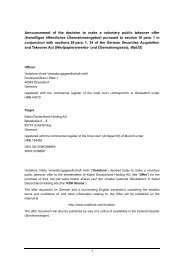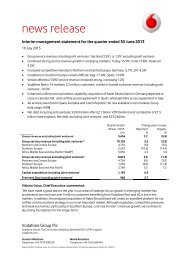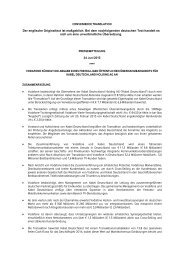Create successful ePaper yourself
Turn your PDF publications into a flip-book with our unique Google optimized e-Paper software.
Moving the debate forward • The Policy Paper Series • Number 8 • April 2008<br />
Differences between termination rates<br />
and marginal costs<br />
Market evidence clearly shows that there has been no<br />
anticompetitive effect of on-net pricing – disproving the<br />
assertion that it is a predatory pricing strategy. This leaves<br />
two rational economic reasons why such pricing exists:<br />
1. Differences in the perceived marginal costs between<br />
on-net and off-net calls; and<br />
2. Call externalities – leading to networks discounting on-net<br />
calls to internalise these call externalities within their own<br />
network (since on-net calls provide the call externality to<br />
the networks’ own subscribers).<br />
The theoretical models predict that, in the case of two-part<br />
tariff (monthly rental plus price per minute) 7 the ratio of<br />
on-net and off-net call charges will be8 :<br />
co + ct<br />
co + a<br />
x<br />
1 - γα/(1 - α)<br />
1 + γ<br />
provided γ(1 + α) < 1 (Formula1)<br />
where co is the marginal cost of call origination;<br />
ct is the marginal cost of call termination;<br />
a is the termination rate;<br />
γ is the call externality factor (the utility of receiving<br />
calls relative to the utility of making calls – a value<br />
of 1.0 indicates equal utility);<br />
α is subscriber market share.<br />
This expression is useful because it allows us to predict on-net<br />
pricing discount as a product of two components: the first is<br />
the ratio between the marginal costs of on-net and off-net<br />
call (the latter including the other network’s termination<br />
rate); and the second, a factor that is only important if there<br />
are call externalities. 9 The two-part tariff model accurately<br />
captures the contract market, whilst the pre-pay market is<br />
best captured by a simply linear tariff model.<br />
The first term can be estimated. Most national regulators<br />
have an objective of cost based call termination pricing. 10<br />
The existing bottom-up mobile network costing models<br />
developed by a number of European regulators are aimed<br />
at providing long run incremental costs plus common cost<br />
mark-ups (in the case of OPTA), or average costs (in the case<br />
of Ofcom). However, the models are also flexible enough to<br />
provide a basis for estimating the long run marginal network<br />
cost of call origination and termination. Typically11 ;<br />
co + ct<br />
≈ 0.5<br />
co + a<br />
Ignoring call externality effects, we would, therefore, expect<br />
to see on-net discounts of around 50%, when averaged across<br />
all tariffs offered by an operator. Comparing this value to<br />
Chart 4, we see that very few MNOs have effective on-net<br />
discounts as high as this. From this we conclude that call<br />
externalities have minimal impact in on-net pricing decisions;<br />
and/or there are other factors that moderate MNOs’ incentive<br />
to offer on-net pricing. The latter would include number<br />
portability (which reduces caller awareness of when a call is<br />
on or off-net), and tariff simplicity (consumers demand the<br />
simplicity of a single retail price across all networks).<br />
On-net Pricing in Mobile<br />
The conclusion that call externalities are of minimal<br />
importance is also supported by the fact that on-net discounts<br />
(from Chart 3) bear no obvious relationship to market share<br />
of the MNOs. From formula (1) we see that, in the presence<br />
of call externalities, we expect on-net discounts to be higher<br />
for networks with a high market share. This is because, in the<br />
presence of call externalities, receipt of off-net calls provides<br />
disproportionately higher value to small networks, and so<br />
their large competitors have greater incentive to increase<br />
off-net call prices – effectively increasing the on-net discount.<br />
In the absence of a call externality large networks derive no<br />
such benefit – and this is what we see in practise.<br />
Conclusion<br />
Differentiation of on-net and off-net call prices has been an<br />
enduring feature of the competition in the European mobile<br />
services market since the mid-1990s. On-net discounting is<br />
often introduced by small networks to gain market share, and<br />
by large networks to defend market share, but neither obtains<br />
a decisive advantage. There is no evidence to suggest that it is<br />
an effective predatory tool.<br />
Although on-net discounts vary across tariff options, the<br />
“average” level appears consistent with marginal cost<br />
differentials for on-net and off-net calls. There is no evidence<br />
for call externalities – another factor that could contribute to<br />
on-net discounting. Rather, MNOs appear to prefer to move<br />
towards eliminating on-net discounting in preference for the<br />
simplicity of flat cross-network tariffs.<br />
Notes<br />
1 Hoernig, S. “On-net and off-net pricing on asymmetric telecommunications<br />
networks”, Information Economics and Policy, 19 (2007) pp171-188.<br />
2 Birke, D. & Swann, G.M.P. (2007) ‘Network Effects in Mobile Telephony’, in Benzoni,<br />
L. & Geoffron, P. (eds.) A Collection of essays on Competition and Regulation with<br />
Asymmetries in Mobile Markets, Quantifica Publishing.<br />
3 The sum of the square of market shares.<br />
4 Weighted average across 25 EU countries.<br />
5 On-net discounts have been calculated in the manner described in the<br />
next section.<br />
6 For a basket sensitivity test, we repeated the analysis for both the low and high<br />
baskets with very similar results in terms of on-net discounts.<br />
7 Unfortunately it is not possible to derive an analytical formula for the on-net<br />
discount under a simple linear pricing model (see Berger (2004), “The Economics<br />
of Two-way Interconnection”). However, it is reasonable to assume that it differs<br />
from the two-part tariff in that prices of both on-net and off-net calls will exceed<br />
their respective marginal costs (in order to cover subscriber specific costs).<br />
8 See, for example, Hoernig, S. (2007), Op. Cit. See equation (16). It is not possible to<br />
provide an equivalent mathematical formula for simple linear tariffs (per minute<br />
charges), but numeric simulations suggest that the on-net discounts will have<br />
very similar properties.<br />
9 If there are call externalities, an MNO would want to reduce the price of on-net<br />
calls (below marginal cost), since stimulating greater volumes of these calls<br />
increases the value of the network to the receivers. Conversely, off-net calls<br />
provide a benefit to another network, and so MNOs will not be willing to discount<br />
these calls. In fact MNOs may want to increase the price of these calls (above<br />
marginal cost) to reduce their volumes and the benefit provided to the<br />
competing network.<br />
10 Some regulators (e.g. Ofcom) add surcharges for network externalities.<br />
11 This is consistent with marginal costs being about one third the termination rate;<br />
results will vary between markets and technology.<br />
41

















